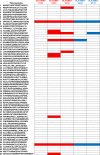Peptidylarginine Deiminase Autoimmunity and the Development of Anti-Citrullinated Protein Antibody in Rheumatoid Arthritis: The Hapten-Carrier Model
- PMID: 31820586
- PMCID: PMC7317357
- DOI: 10.1002/art.41189
Peptidylarginine Deiminase Autoimmunity and the Development of Anti-Citrullinated Protein Antibody in Rheumatoid Arthritis: The Hapten-Carrier Model
Abstract
Objective: The presence of autoantibodies to citrullinated proteins (ACPAs) often precedes the development of rheumatoid arthritis (RA). Citrullines are arginine residues that have been modified by peptidylarginine deiminases (PADs). PAD4 is the target of autoantibodies in RA. ACPAs could arise because PAD4 is recognized by T cells, which facilitate the production of autoantibodies to proteins bound by PAD4. We previously found evidence for this hapten-carrier model in mice. This study was undertaken to investigate whether there is evidence for this model in humans.
Methods: We analyzed antibody response to PAD4 and T cell proliferation in response to PAD4 in 41 RA patients and 36 controls. We tested binding of 65 PAD4 peptides to 5 HLA-DR alleles (DRB1*04:01, *04:02, *04:04, *01:01, and *07:01) and selected 11 PAD4 peptides for proliferation studies using samples from 22 RA patients and 27 controls. Peripheral blood lymphocytes from an additional 10 RA patients and 7 healthy controls were analyzed by flow cytometry for CD3, CD4, CD154, and tumor necrosis factor expression after PAD4 stimulation.
Results: Only patients with RA had both antibodies and T cell responses to PAD4. T cell response to peptide 8, a PAD4 peptide, was associated with RA (P = 0.02), anti-PAD4 antibodies (P = 0.057), and the shared epitope (P = 0.05).
Conclusion: ACPA immunity is associated with antibodies to PAD4 and T cell responses to PAD4 and PAD4 peptides. These findings are consistent with a hapten-carrier model in which PAD4 is the carrier and citrullinated proteins are the haptens.
© 2019 INSERM. Arthritis & Rheumatology published by Wiley Periodicals, Inc. on behalf of American College of Rheumatology.
Figures






Similar articles
-
Peptidyl arginine deiminase immunization induces anticitrullinated protein antibodies in mice with particular MHC types.Proc Natl Acad Sci U S A. 2017 Nov 21;114(47):E10169-E10177. doi: 10.1073/pnas.1713112114. Epub 2017 Nov 6. Proc Natl Acad Sci U S A. 2017. PMID: 29109281 Free PMC article.
-
How RA Associated HLA-DR Molecules Contribute to the Development of Antibodies to Citrullinated Proteins: The Hapten Carrier Model.Front Immunol. 2022 Jun 10;13:930112. doi: 10.3389/fimmu.2022.930112. eCollection 2022. Front Immunol. 2022. PMID: 35774784 Free PMC article. Review.
-
Do RA associated HLA-DR molecules bind citrullinated peptides or peptides from PAD4 to help the development of RA specific antibodies to citrullinated proteins?J Autoimmun. 2021 Jan;116:102542. doi: 10.1016/j.jaut.2020.102542. Epub 2020 Sep 11. J Autoimmun. 2021. PMID: 32928608
-
Prevalence of anti-peptidylarginine deiminase type 4 antibodies in rheumatoid arthritis and unaffected first-degree relatives in indigenous North American Populations.J Rheumatol. 2013 Sep;40(9):1523-8. doi: 10.3899/jrheum.130293. Epub 2013 Aug 1. J Rheumatol. 2013. PMID: 23908443 Free PMC article.
-
Clinical and immunological aspects of anti-peptidylarginine deiminase type 4 (anti-PAD4) autoantibodies in rheumatoid arthritis.Autoimmun Rev. 2018 Feb;17(2):94-102. doi: 10.1016/j.autrev.2017.11.023. Epub 2017 Dec 2. Autoimmun Rev. 2018. PMID: 29196243 Review.
Cited by
-
PAD4 Immunization Triggers Anti-Citrullinated Peptide Antibodies in Normal Mice: Analysis With Peptide Arrays.Front Immunol. 2022 Mar 31;13:840035. doi: 10.3389/fimmu.2022.840035. eCollection 2022. Front Immunol. 2022. PMID: 35432329 Free PMC article.
-
The Citrullination-Neutrophil Extracellular Trap Axis in Chronic Diseases.J Innate Immun. 2022;14(5):393-417. doi: 10.1159/000522331. Epub 2022 Mar 9. J Innate Immun. 2022. PMID: 35263752 Free PMC article. Review.
-
PAD2 immunization induces ACPA in wild-type and HLA-DR4 humanized mice.Eur J Immunol. 2022 Sep;52(9):1464-1473. doi: 10.1002/eji.202249889. Epub 2022 Jun 25. Eur J Immunol. 2022. PMID: 35712879 Free PMC article.
-
B Cells in Rheumatoid Arthritis:Pathogenic Mechanisms and Treatment Prospects.Front Immunol. 2021 Sep 28;12:750753. doi: 10.3389/fimmu.2021.750753. eCollection 2021. Front Immunol. 2021. PMID: 34650569 Free PMC article. Review.
-
Construction of CII-Specific CAR-T to Explore the Cytokine Cascades Between Cartilage-Reactive T Cells and Chondrocytes.Front Immunol. 2020 Dec 4;11:568741. doi: 10.3389/fimmu.2020.568741. eCollection 2020. Front Immunol. 2020. PMID: 33343563 Free PMC article.
References
-
- Astorga GP, Williams RC Jr. Altered reactivity in mixed lymphocyte culture of lymphocytes from patients with rheumatoid arthritis. Arthritis Rheum 1969;12:547–54. - PubMed
-
- Gregersen PK, Silver J, Winchester RJ. The shared epitope hypothesis: an approach to understanding the molecular genetics of susceptibility to rheumatoid arthritis. Arthritis Rheum 1987;30:1205–13. - PubMed
-
- Aletaha D, Neogi T, Silman AJ, Funovits J, Felson DT, Bingham CO III, et al. 2010 rheumatoid arthritis classification criteria: an American College of Rheumatology/European League Against Rheumatism collaborative initiative. Arthritis Rheum 2010;62:2569–81. - PubMed
Publication types
MeSH terms
Substances
LinkOut - more resources
Full Text Sources
Medical
Molecular Biology Databases
Research Materials

